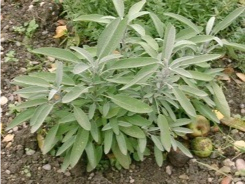Common Name: Garden Sage, Common Sage
Latin proper name: Salvia officinalis
 Sage is a perennial evergreen shrub and generally grows about 30 to 60 cm high, with wiry stems. The leaves are set in pairs on the stem, are about 3 to 5 centimeters long, rounded at the ends, greyish-green and softly hairy. The flowers are in whorls, blue to purplish and the corollas lipped, they blossom in late spring or summer. All parts of the plant have a strong, scented odor and a warm, bitter, somewhat astringent taste.
Sage is a perennial evergreen shrub and generally grows about 30 to 60 cm high, with wiry stems. The leaves are set in pairs on the stem, are about 3 to 5 centimeters long, rounded at the ends, greyish-green and softly hairy. The flowers are in whorls, blue to purplish and the corollas lipped, they blossom in late spring or summer. All parts of the plant have a strong, scented odor and a warm, bitter, somewhat astringent taste.
Distribution
Sage grows in its natural wild condition on mountain hills in many places throughout the world and it doesn’t need much soil. When wild it is more shrubby in appearance and has a more penetrating odor, it is more spicy and astringent than the cultivated plant. Sage is a very variable species in gardens or cultivations it can grow with differently shaped leaves and smaller or white flowers.
Growing your own Sage
It is propagated occasionally by seed, but more frequently by cuttings. You pull off the young shoots from three-year-old plants in spring, as soon as they attain a sufficiency of hardness to enable them to maintain themselves on the moisture of the ground. See that the young plants do not suffer from lack of water during their first summer. They like a situation shaded from sunshine but not strictly under trees. It is propagated occasionally by seed, but more frequently by cuttings. You pull off the young shoots from three-year-old plants in spring, as soon as they attain a sufficiency of hardness to enable them to maintain themselves on the moisture of the ground. See that the young plants do not suffer from lack of water during their first summer. They like a situation shaded from sunshine but not strictly under trees.
Medicinal Uses
Parts used: Leaves, whole herb. In older times it was a very celebrated medicinal herb and there is a proverb saying: „Why should a man die whilst sage grows in his garden?“ The principal application is a wash for the cure of affection of the mouth and a gargle in inflamed sore throat and for bleeding gums. Old peasants ate Sage as a preservative of health and there are old sayings that Sage is singularly good for the head and brain, that it quickens the senses and the memory and restores the health to those that have the palsy as it will help against trembling. The tea is a stimulant tonic for a weak stomach and weak digestion generally. A cup of the strong infusion will help relieve nervous headache. Fresh leaves, rubbed on the teeth, will cleanse them and strengthen the gums. Here some applications
Tea and gargle
For tea pour half a liter of boiling water on a tablespoon of dried or fresh leaves and steep for 10 minutes. Its good for drinking or gargling. For a more stimulating effect to the throat the gargle can be made of equal quantities of vinegar and water: Pour hot vinegar on the leaves and add the same amount of cold water.
Poultice
A cure for sprains. Bruise a handful of fresh Sage leaves and boil them in a glass of vinegar for 5 minutes, apply this in a folded napkin as hot as it can be borne to the part affected.
Culinary Uses
Added in soups and sauces it enables the stomach to digest rich food.
Harvesting and drying Sage leaves
Harvest lightly the first year. Harvest before flowering. If you cut whole branches bundle 4-6 branches together and tie as a bunch. Then cut several holes in a paper bag and label the bag with the name of the herb you are drying. Place the bundle upside down into the bag. Gather the ends of the bag around the bundle and tie closed. Make sure the herbs are not crowded inside the bag. Hang the bag upside down in a warm, airy room. When they are dried store them in air tight containers and label them with name and date. Place containers in a dry place away from sunshine. Use about 1 TEAspoon crumbled dried leaves in place of 1 TABLEspoon of fresh ones.


